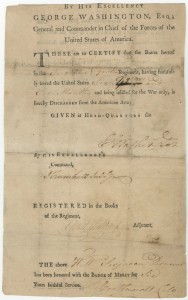Item: George Washington Signed Document, Discharging a Regimental Drummer
Sold For: $12,000.00
Bids: 1
Date: Jul 01, 2012
Auction: Ebay
Description and Image By: sethkaller
Washington Discharges a Regimental Drummer After Six Years of Faithful Service “The above Will.m Serjason Drummer has been honored with the Badge of Merit for Six Years faithful Service…” Regimental fifers and drummers were integral parts of 18th century military life. Drummers and drumming communicated orders on the battlefield, around camp, drill, and parade grounds. Drum beats, or “tattoos,” directed everything from assembling into ranks, to gathering wood and water, to marching in formation. Likewise, fifers helped communicate troop movements on chaotic battlefields. Here, William Serjason receives an honorable discharge and the Badge of Merit, an award created by Washington intended for enlisted men and non-commissioned officers. GEORGE WASHINGTON. Partially Printed Document Signed. Also signed by John Trumbull, Jr., Christopher Shilton, and Philip Cortlandt. [Newburgh, N.Y.], [June 1783]. 1 p., 7½ x 11¾ in. Inventory #22645 Complete Transcript By His Excellency George Washington, Esq; General and Commander in Chief of the Forces of the United States of America. These are to Certify that the Bearer hereof Will.m Serjason Drummer in the Second N. York Regiment, having faithfully server the United States Six Years and Six Months and being inlisted for the War only, is hereby Discharged from the American Army. Given at Head-Quarters the [signed] G:o Washington By His Excellency’s Command, J Trumbull Jun Esqr Registered in the Books of the Regiment, / Christ.r Shilton Adjutant The above Will.m Serjason Drummer / has been honored with the Badge of Merit for Six / Years faithful Service / P. Cortlandt, Colo. [On verso] Head-Quarters, June 1783. The within Certificate shall not avail the Bearer as a Discharge, until the Ratification of the definitive Treaty of Peace; previous to which Time, and until Proclamation thereof shall be made, He is to be considered as being on Furlough. George Washington. Historical Background For his six years of service in Philip Van Cortlandt’s 2nd New York Regiment, drummer William Serjason received an honorable discharge and the Badge of Merit. The Badge was created by Washington as an award for enlisted men and non-commissioned officers – something that would never have been considered in the Old World. Finishing three years of loyal service “with bravery, fidelity, and good conduct” earned rank-and-file troops a chevron, worn on their uniform coat’s left sleeve. For six years of service, two chevrons were worn. At the end of 1775 and throughout 1776, men enlisted for short, set time periods. Army reforms in 1777 ended problems created by the practice by switching to enlistments for three years, or “the entire term of the war.” Between October 19, 1781 when Cornwallis surrendered to American and French forces in Yorktown, Virginia and the Peace of Paris, signed September 3, 1783, British and American forces continued to skirmish in frontier areas of North America, and in Caribbean and Atlantic waters. Washington maintained a fighting force while continuing the peace process. After several strategic losses to the French navy, and turmoil at the highest levels of the British government, King George III issued a Proclamation of the Cessation of Hostilities in February. Congress responded with a similar proclamation in April, and attention turned from continued military actions to peace negotiations. By the time of this June discharge, negotiations led by John Adams, Benjamin Franklin, and John Jay with British representatives were nearing a conclusion. The British government was again in a state of flux, but the Americans refused any modifications to any earlier agreed-upon terms, largely due to the delays of two Atlantic crossings to obtain Congressional approval. Finally, on September 3, 1783, British and American negotiators signed the Peace of Paris. William Serjason, who had “inlisted for the War only,” earned an honorable discharge for his service as drummer in the Continental Army for six years and six months. Under the terms of its discharge, Serjason technically remained in Washington’s service until the Confederation Congress ratified the final treaty on January 14, 1784. Condition Very good. Treated by a professional paper conservator. Sources “The Badge of Military Merit/The Purple Heart.” http://www.history.army.mil/html/reference/purhrt.html “Drum Beatings for a Typical Day in a Revolutionary War Camp.” http://www.fifedrum.org/crfd/CRFD6.htm

